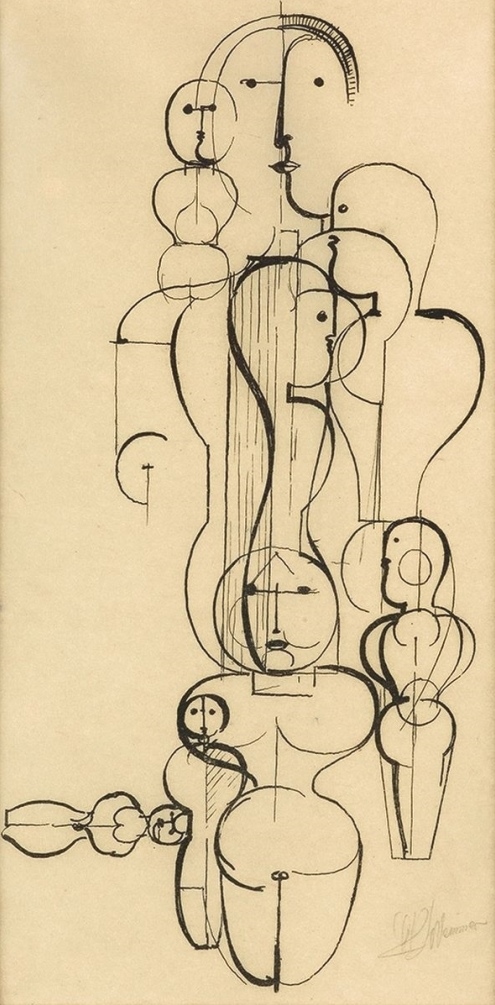Lithograph on cream Japan paper by Oskar Schlemmer – Titled: Concentric group, 1921
Limited edition fine art print by Oskar Schlemmer – Titled: Konzentrische Gruppe from Figurenplan K 1; 1921 (Concentric group)
Lithograph on cream color Japan paper signed in pencil by the artist on lower right. One of an edition of 110 signed lithographs.
Dimensions: Full margins: 40.7 x 19.8 cm – 16 x 7.75 in.
Printer: Staatliches Bauhaus, Weimar, Germany
Publisher: Müller & Co. Verlag, Potsdam, Germany
References: Klipstein und Kornfeld 1962; . Grohmann L 8; Neue europäische Graphik- Mappe 1: Meister des Staatlichen Bauhauses in Weimar .
!!!Note: Seen similar lithography on Galerie Nierendorf catalogue (Berlin, Germany)
Price: * Please contact gallery for more information on artwork, artist, price or other details
Clic here to see more fine art prints>>
Oskar SCHLEMMER (1888 – 1943)
Oskar Schlemmer was born on the 4 of September 1888 and died on the 13 of April 1943. He was a German painter, sculptor, designer and choreographer associated with the Bauhaus school.
In 1923, he was hired as Master of Form at the Bauhaus theatre workshop, after working at the workshop of sculpture. His most famous work is Triadisches Ballett (Triadic Ballet), which saw costumed actors transformed into geometrical representations of the human body in what he described as a “party of form and colour”
In 1903 he was completely independent and supporting himself as an apprentice in an inlay workshop, moving on to another apprenticeship in marquetry from 1905 to 1909.
Oskar Schlemmer studied at the Kunstgewerbeschule (School of Applied Arts) in Stuttgart and won a scholarship to attend the Akademie der Bildenden Künste (Stuttgart Academy of Fine Art), where he studied under the tutelage of landscape painters Christian Landenberger and Friedrich von Keller starting in 1906.
In 1910 Schlemmer moved to Berlin where he painted some of his first important works before returning to Stuttgart in 1912 as the master pupil of abstract artist Adolf Hölzel, abandoning impressionism and moving toward cubism in his work. In 1914 Schlemmer was enlisted to fight on the Western Front in World War I until he was wounded and moved to a position with the military cartography unit in Colmar, where he resided until returning to work under Hölzel in 1918.
In 1919 Schlemmer turned to sculpture and had an exhibition of his work at the gallery Der Sturm in Berlin. At the same time he helped to update the curriculum at the Stuttgart Academy of Fine Art with the appointment of new faculty and exhibitions of modern art. Among those involved were Paul Klee and Willi Baumeister.
After his marriage to Helena Tutein in 1920, Schlemmer was invited to Weimar by Walter Gropius to run the mural-painting and sculpture departments at the Bauhaus School before taking over the stagecraft workshop from Lothar Schreyer in 1923. His complex ideas were influential, making him one of the most important teachers working at the school at that time. However, due to the heightened political atmosphere in Germany at the end of the 1920s, and in particular with the appointment of the radical communist architect Hannes Meyer as Gropius’s successor, in 1929 Schlemmer resigned his position and moved to take up a job at the Art Academy in Breslau.
Schlemmer became known internationally with the première of his ‘Triadisches Ballett’ in Stuttgart in 1922.
His work for the Bauhaus and his preoccupation with the theatre are an important factor in his work, which deals mainly with the problematic of the figure in space.
Date:
December 10, 2020
See more artworks and bio of
AA-Graphic arts